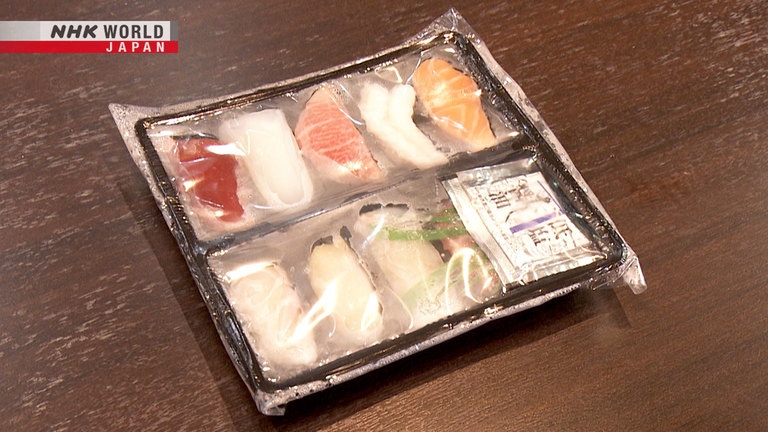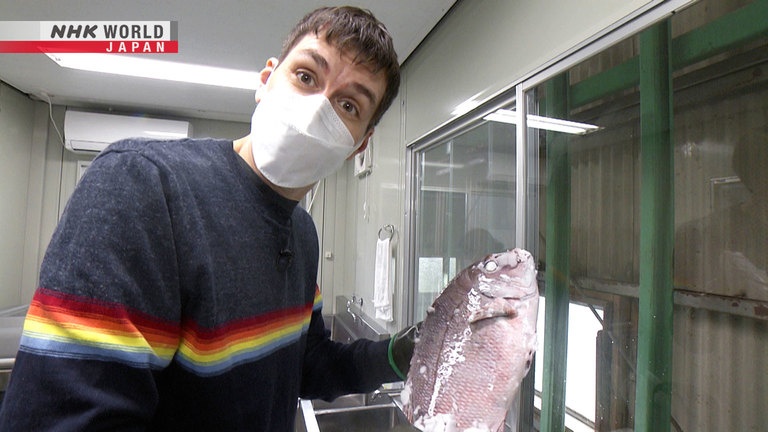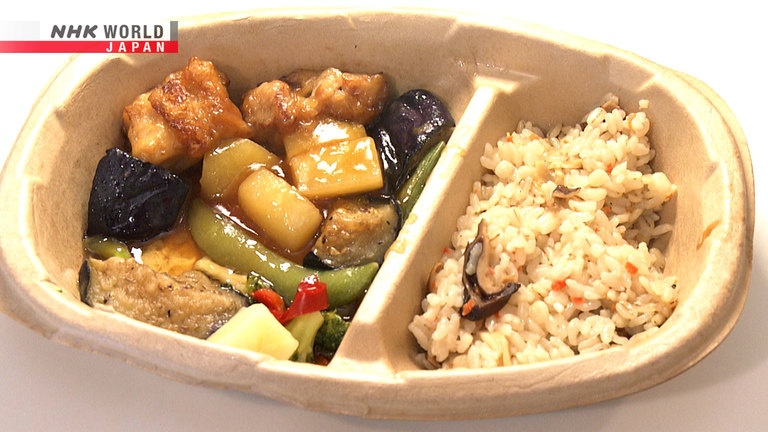Frozen Food
*First broadcast on July 28, 2022.
In Japan, frozen food is an essential part of many people's lives. Companies are constantly developing new techniques that make products tastier, longer lasting and more convenient. Our guest, consumer consultant Miura Yoshiko, explains why frozen food is so popular. She introduces some of the latest developments, such as flash freezing. And in Plus One, Matt Alt learns about new types of ice.



Transcript
Hello, and welcome to
Japanology Plus.I'm Peter Barakan.
Our theme for today is frozen food.
When you think of Japanese food
I'm sure a lot of people will immediately
have images of things like sushi,
which would seem to be
a world away from frozen food.
But in fact, the Japanese
predilection for raw fish
is one of the reasons that
the country has developed
some very innovative
freezing technologies.
There are something like 5,000 varieties
of frozen food on the market in Japan.
And I'm told that
the average annual consumption of frozen
food is something like 23 kilograms.
It sounds like an awful lot.
Anyway—let's chill.
Few countries enjoy
frozen food as much as Japan.
Most supermarkets have
a dedicated section for it,
offering hundreds of different products.
Here's a selection featuring rice.
Fried rice is especially popular.
In fact, the market for frozen fried rice
generates annual sales of 15 billion yen,
and makers compete fiercely.
But the biggest seller
among frozen foods is pasta.
There's a wide variety, with over
one hundred products on the market.
Here, we have mixed vegetables.
Vegetables used in various
styles of cuisine are available.
But just how prominently do frozen
products feature in daily life?
I use them five days a week,
when making bento lunches for my family.
As both my husband and I work,
we make meals from frozen
food at least once a day.
Let's take a closer look
at this woman's routine.
Each morning, she makes
bento lunches for her family.
This pack features six frozen side dishes,
designed to be the perfect
size for use in bento.
They can be added as-is.
By lunchtime, they'll have thawed,
and will be ready to eat.
A few finishing touches,
and the food looks handmade!
Today's lunch features chilled noodles—
a new frozen-food product.
The noodles are covered in pieces of ice!
The meal is microwaved
for around three minutes.
While the noodles get hot,
the ice is unaffected.
But now it melts to chill the noodles.
Add the toppings,
and the dish is complete.
A great meal for summer.
Her husband often gets
home from work late in the evening.
He grabs a couple
of packs from the freezer.
I never know what time I'll be back.
If it's late, I do this.
He warms up nutritious snacks
to enjoy with a cold drink.
Frozen food can help to
maintain a balanced diet
even when eating late in the evening.
For many Japanese, frozen food
is an essential part of daily life.
Frozen food is constantly evolving,
and so are freezing techniques.
This shop near Tokyo stocks products
that were frozen using
a brand-new flash freezing technique,
developed by a freezer-making company.
Hello.
Hello.
Tsudatani Hideki works for the company.
This shop stocks products
frozen using our technique.
There are around 500 varieties.
500! Wow. Can you show me some of them?
Of course. This way.
This is the seafood section.
Oh yes, I see.
Oh, are these sashimi?
Yes. They're frozen when
they're at their freshest.
When they're in season.
So they can be enjoyed
in peak condition, all-year-round.
I think you'll enjoy this product.
It's sushi.
Oh my god. You actually freeze sushi! Wow.
The sushi was handmade
by a professional chef, and flash frozen.
The texture and freshness are just like
that of fish straight from the market.
This is shirasu—very small fish.
Yeah, yeah, I love them. Yeah.
The white color suggests they've been
boiled, but they're actually raw.
Oh really?
Yes. Fishermen say they're so fresh,
you can't tell they were ever frozen.
OK.
Let's defrost the sushi, and have a taste.
You use hot water.
Oh, OK.
The water will only cover the bottom part.
After 30 to 40 minutes, it's ready to eat.
So with the hot water,
the rice is going to get warmed up.
Won't the fish also get overheated?
What happens is that
the rice heats up first.
But since it's frozen, the heat
makes its way up extremely slowly.
By the time it gets to the fish,
the amount of heat
being applied is very gentle.
And so in fact the fish do not overheat.
After 30 minutes, the color
and texture look right.
But what about the taste?
Yeah, the texture's really good.
Fabulous.
If I'd been asked, “Was that frozen?”
I would have said, “No.”
Good, isn't it?
Next, we'll defrost
the shirasu, using iced water.
After 15 minutes, it's ready to eat.
Flash freezing extends the shelf life
from one day to half a year.
It's really fresh.
That's excellent.
The secret behind these products
is this flash freezer.
It uses liquid to freeze
food in a brand-new way.
Tell me how it works.
This is ethanol.
The ethanol is at minus
30 degrees Celsius.
With normal freezers,
you place food in a cold space.
We use liquid.
You seal food in plastic
packages, and put them in.
-You can see it changing color already.
-Yes.
Just after a few seconds.
You can see the effect on the surface.
Then the inside freezes too.
It happens incredibly quickly.
Just three minutes later,
the pack of salmon is frozen solid.
It's like a board, yeah.
Exactly.
Flash freezing in this way
preserves the freshness.
Let's see why flash
freezing is so effective.
In a normal freezer,
the water in food cells comes together
to form ice crystals.
These big crystals damage cell membranes.
When thawed,
the liquid drips out, taking a lot of
the flavor along with it.
Flash freezing happens so quickly that
the cells end up being better protected.
When thawed,
the great taste is still there.
The food's condition has barely changed.
Something that's distinctive about Japan
is our love of raw foods:
sashimi, sushi and so on.
You get the unadulterated
taste of the ingredients.
Our freezing technique lets people
enjoy food in that condition.
Japanese people started
cooling food in the 17th century,
at around the same time that
raw fish became widely consumed.
It's believed that ice
from special storehouses
was used to keep fish fresh
during transportation.
However, ice was a valuable commodity,
and only people of
high social status had access to it.
The general public
didn't have access to ice,
so instead, they lowered food into wells,
which became makeshift refrigerators.
A freezer for business use was developed
in the early 20th century.
This enabled fish to be frozen
and transported around the country.
Home-use iceboxes appeared
at around the same time.
There was a compartment
at the top, for ice...
and a compartment below, for food.
Refrigerators incorporating small freezer
sections became popular in the 1960s,
when Japan was enjoying a booming economy.
This went hand-in-hand with a rapid growth
in the frozen food market.
Most of the products back then
were potato croquettes, shrimp and other
breaded foods that would be deep fried.
From the late '70s,
more and more homes had a microwave.
Many people also had a fridge-freezer
with two entirely separate compartments.
This led to many new frozen foods,
designed to be warmed up in the microwave.
That trend has only continued, with new
products being developed all the time.
Miura-san, thank you very much for
joining us on the program today.
My pleasure. Thank you for having me.
Our guest this time is consumer
consultant Miura Yoshiko.
She works on behalf of an association
specializing in frozen food.
Frozen foods have been
around for a long time.
Why is it that they're
so popular in Japan now?
Lately, more and more Japanese women
are working outside the home.
But they also tend to
prepare food for the family.
Their time is very limited.
Also, Japan's population is aging,
and a great many people live alone.
Assembling ingredients, then preparing
and cooking them, takes time and effort.
Frozen food helps to address that problem.
It has evolved to suit
the needs of consumers.
For example, if someone
doesn't want to fry food themselves,
they can buy a version
that can be microwaved.
Frozen food is addressing
that kind of demand.
Another factor is bento—boxed lunches.
In Japan, they're eaten regularly,
by people of all ages.
Various frozen ingredients were developed
to meet that demand.
Bento typically were made at home and...
so do people use frozen
ingredients now for bento?
Yes.
You might add a few vegetables,
or embellish a home-made dish
with something from the freezer.
You might want to add
more meat, or more fish.
It's all available.
That variety is one reason why frozen
bento ingredients have become so popular.
Can you talk about maybe some
of the new developments?
Something I wanted to show you today
is these: all-in-one meals.
They're perfect for
an evening meal, or for lunch.
You don't need to worry about
adding anything else.
You get the whole meal.
This one has mixed rice with
sweet-and-sour chicken and vegetables.
It has 13 different ingredients.
In other words, it's a balanced meal.
You can eat them anywhere;
even at some convenience stores.
As long as you have access to a microwave,
you can heat one up, and enjoy a meal.
So they're incredibly useful.
The tray is designed for the microwave,
so you can put it straight in.
Let's give it a go.
The wrapper says it will take 5 minutes
and 20 to 40 seconds.
OK, so make it five-and-a-half
minutes, maybe.
Japanese frozen foods come with
detailed instructions
on how they should be warmed up.
Simply follow those steps,
and you'll get a perfect dish, every time.
Give it a try. It's piping hot.
That is quite tasty.
Ah, good!
It comes in a paper tray,
so it's eco-conscious.
OK, so is that biodegradable?
Yes. That's right.
The tray also has a feature that
helps to evenly distribute heat.
A microwave's electromagnetic waves
become concentrated in sharp corners,
which can overheat.
Rounded trays were developed
to alleviate the problem.
They have fewer sharp corners,
but in this case two remain.
In those spots, slopes are added to spread
heat evenly throughout the container.
Another new trend is products
that can be eaten straight out of the bag.
Oh my gosh.
Surprising, isn't it?
The wrapper itself is
very cleverly designed.
You can put it into
the microwave, just as-is.
Then you cut it open,
and use it as a bowl.
It's amazing.
This range of frozen products is designed
to be microwaved in the bag.
When it's ready, you can
simply open it up, and tuck in.
It's going to be really hot.
It is hot.
The seasonings are very carefully chosen.
The flavors are designed to be appealing
to as many people as possible.
That's really tasty.
I'm glad! There's an
enormous variety of products.
Dishes from a particular restaurant,
or those found only in certain regions,
can be flash frozen,
and sold in vending machines.
Yes; I've seen them recently.
During the pandemic,
people couldn't always go to restaurants
and order what they wanted.
Vending machines allow customers to
buy what they want, when they want.
So we're seeing more of
them appear around the country.
Hi, I'm Matt Alt, and this is Plus One.
On this rainy summer day, I've come to
the city of Sakura, in Chiba Prefecture,
to investigate the cutting edge of
refrigeration technology.
They tell me there's a company here
that's invented a unique
and specialized type of ice.
What's it all about?I don't know!
Come on, let's check it out.
The ice is made at this facility.
Hello there.
They tell me that you're doing some really
interesting stuff with ice here.
Yes, and I'd be delighted to show you.
We make our special ice
using this machine.
Oh wow.
That's super cold!
Regular ice is 0 degrees Celsius.
But this ice is much colder than that.
Let's measure the temperature.
It's minus 21 degrees.
The ice is made using water
with a high concentration of salt.
Salt water is applied to a metal plate
that is chilled to minus 60 degrees.
The water freezes instantly,
and is turned into flakes.
This ice is used by restaurants and
fishmongers to speedily freeze seafood.
Let's see it in action.
First, the ice is spread out.
Salt water is poured on top.
Why do you mix these together like this?
It creates a kind of sludge that clings to
whatever you want to freeze.
Let's freeze this.
Red snapper!
It's submerged for around 40 seconds.
Wow.
Totally frozen.
Wow...oh...wow, now this is really hard.
This is really hard now!
It's like a club or
something! Look at this.
So this is very interesting,
but why did you develop this ice?
When defrosted,
it's as fresh as it was before.
It's delicious!
The process also kills any harmful
organisms in the fish, such as parasites.
The company is also developing a technique
to make even colder ice.
Here it is.
It's frozen ethanol,
which can go down to even
lower temperatures than salt water can.
The temperature is lower
than minus 120 degrees.
It is expected to be useful
in transporting medical vaccines,
which need to be kept at
an extremely low temperature.
This is raw skipjack tuna,
flash frozen one year ago.
Is this edible?
Itadakimasu.
Ready?
Oh wow.
This tastes perfectly fresh.
A regular freezer wouldn't
achieve the same result.
You know how frozen foods often have
that kind of “freezer” taste to them?
And this just...this doesn't at all.
It's really amazing.
Well there you have it;
a look at some of Japan's most up-to-date,
cutting-edge freezing technology.
Next time you come to Japan,
try some for yourself.
I think you'll find it incredibly cool.
See you next time.
Following the outbreak of COVID-19,
people were encouraged to stay at home,
and restaurants struggled
to stay in business.
This restaurant, which
specializes in sardine dishes,
got through those tough times
by using flash freezing.
They installed a new kind
of flash freezer,
and began selling their popular
sardine tempura online.
It can be stored for up to a year.
Simply warm it up in the microwave...
and it comes out crispy and delicious.
Freezing proved to be a great idea,
and sales soon increased.
The restaurant also flash
freezes raw sardines.
This makes it possible to
serve fresh fish at any time.
Today, the number of people dining
in person is steadily increasing.
It tastes perfectly fresh, without fail.
New freezing techniques are also
being used to reduce food loss.
A fruit wholesaler in Nagoya
has started flash freezing fruit that
previously would have been thrown away.
It can be stored, and used later.
They're quite damaged.
Produce with damaged skin
often goes unsold,
even if the inside is perfectly fine.
Previously, these would
have been disposed of.
Instead, this company
began cutting the fruit up,
flash freezing it,
and selling it to restaurants.
The price is around 30 percent cheaper
than undamaged fruit, and it sells well.
Cut oranges like these are used
in parfaits, or to make jam.
Persimmons are used on pizzas.
And grapes can go in drinks.
This approach may reduce fruit wastage
by around a million tons per year.
In producing areas,
I think a freezing technique like this
can solve a lot of problems.
I hope it will have a positive impact.
In Japan, cutting-edge freezing techniques
are supporting businesses,
and making life a little easier.
There are all these new
and very impressive technologies.
How specific are they to Japan?
Do they apply to other countries as well?
Japanese freezing technologies are
actually used all over the world.
In Africa, for example,
they have some well-stocked fisheries,
but they can't preserve all
of the fish they could catch.
It would just spoil.
As a solution, they're using
Japanese freezing methods.
If the fish are flash frozen,
they last for a long time.
They can be enjoyed later.
The fish will still be delicious,
and none will go to waste.
Japanese companies have made their
freezing technologies available in Africa.
Thanks to these initiatives, fish can be
transported locally, or exported to Japan.
And the developments seem to
be happening one after another.
Is there still more to come?
Well, when it comes to food,
human desires don't really have a limit.
We want it to taste better,
be ready sooner, and be more convenient.
Japanese frozen foods
have long addressed those demands,
and moving forward,
companies will carry on competing
to develop products
that will match consumer lifestyles.
We also have products
that are safe to consume some time
after natural defrosting.
They might sit in 35-degree heat
for nine hours, but they're safe to eat.
That's a plus because defrosting them
doesn't consume electricity.
We can expect to see more
products like that in the future.
One of the great things about frozen food
is that you can save so much time.
You're not cutting corners;
it's not a negative thing.
You can free up time to spend
talking with your family,
playing with your kids,
or pursuing your hobbies.
Those moments are so important.
Frozen food helps people to make
effective use of their free time,
and I think that's
one of its big advantages.
Thank you very much.
Thank you.